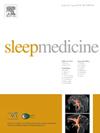Samelisant (SUVN-G3031), a histamine 3 receptor inverse agonist: Results from the phase 2 double-blind randomized placebo-controlled study for the treatment of excessive daytime sleepiness in adult patients with narcolepsy
IF 3.8
2区 医学
Q1 CLINICAL NEUROLOGY
引用次数: 0
Abstract
Narcolepsy is a rare, chronic neurological disorder characterized by a dysregulated sleep-wake cycle, with core clinical features including excessive daytime sleepiness (EDS), cataplexy, hypnopompic/hypnagogic hallucinations, and sleep paralysis. Several treatment options are available for the symptomatic management of narcolepsy, but they have limitations. Comorbidities of narcolepsy further limit the treatment choices. Blocking of histamine 3 (H3) receptors has been demonstrated to be a viable approach for the management of symptoms of narcolepsy. Samelisant (SUVN-G3031) is a new H3 receptor inverse agonist. The efficacy, safety, tolerability, and pharmacokinetics of Samelisant in narcolepsy patients were evaluated in a phase 2, double-blind, placebo-controlled study (ClinicalTrials.gov identifier: NCT04072380). Patients diagnosed with narcolepsy according to the International Classification of Sleep Disorders criteria and having an Epworth Sleepiness Scale (ESS) score of ≥12 and a mean Maintenance of Wakefulness Test (MWT) time of <12 min across the 4 sessions at baseline were enrolled. The total study duration was up to 7 weeks, which included a screening period of 4 weeks, a treatment period of 2 weeks, and a safety follow-up 1 week after the last study drug administration. The primary efficacy measure was the change in total ESS score compared to placebo. Secondary and exploratory assessments included the Clinical Global Impression of Severity, MWT, Clinical Global Impression of Change, Patient Global Impression of Change and cataplexy rate. Safety assessments included monitoring adverse events (AEs) and laboratory assessments. Of the 426 patients screened, 190 were randomized. The safety and intention-to-treat population included 188 and 164 patients, respectively. A statistically significant treatment effect of Samelisant was observed on the primary endpoint, indicating improvements in EDS. The treatment's impact on EDS was also evident on the other patients' and clinicians' perspectives scales. The AEs reported in ≥5 % patients in any treatment groups were insomnia, abnormal dreams, nausea, and hot flush. Global phase 3 studies and long-term safety and efficacy assessments of Samelisant are planned to reaffirm the current findings.
组胺 3 受体反向激动剂 Samelisant(SUVN-G3031):治疗成年嗜睡症患者白天过度嗜睡的第 2 期双盲随机安慰剂对照研究结果。
嗜睡症是一种罕见的慢性神经系统疾病,其特征是睡眠-觉醒周期失调,核心临床特征包括白天过度嗜睡(EDS)、紧张性瘫痪、催眠/幻觉和睡眠瘫痪。目前有几种治疗方法可用于嗜睡症的对症治疗,但这些方法都有局限性。嗜睡症的合并症进一步限制了治疗选择。阻断组胺 3(H3)受体已被证明是治疗嗜睡症症状的一种可行方法。Samelisant (SUVN-G3031) 是一种新型 H3 受体反向激动剂。一项 2 期双盲安慰剂对照研究评估了 Samelisant 对嗜睡症患者的疗效、安全性、耐受性和药代动力学(ClinicalTrials.gov 标识符:NCT04072380)。根据《国际睡眠障碍分类》标准被诊断为嗜睡症的患者,其爱普沃斯嗜睡量表(ESS)评分≥12分,平均保持清醒测试(MWT)时间为
本文章由计算机程序翻译,如有差异,请以英文原文为准。
求助全文
约1分钟内获得全文
求助全文
来源期刊

Sleep medicine
医学-临床神经学
CiteScore
8.40
自引率
6.20%
发文量
1060
审稿时长
49 days
期刊介绍:
Sleep Medicine aims to be a journal no one involved in clinical sleep medicine can do without.
A journal primarily focussing on the human aspects of sleep, integrating the various disciplines that are involved in sleep medicine: neurology, clinical neurophysiology, internal medicine (particularly pulmonology and cardiology), psychology, psychiatry, sleep technology, pediatrics, neurosurgery, otorhinolaryngology, and dentistry.
The journal publishes the following types of articles: Reviews (also intended as a way to bridge the gap between basic sleep research and clinical relevance); Original Research Articles; Full-length articles; Brief communications; Controversies; Case reports; Letters to the Editor; Journal search and commentaries; Book reviews; Meeting announcements; Listing of relevant organisations plus web sites.
 求助内容:
求助内容: 应助结果提醒方式:
应助结果提醒方式:


